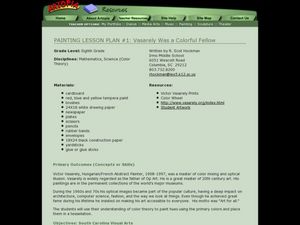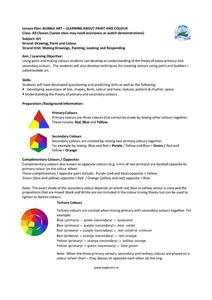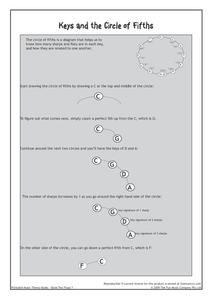Curated OER
da Vinci: Body Proportion Theories
Middle schoolers investigate the validity of da Vinci's proportion theory by recording human measurements on scatter plots. In groups of three, they record each other's height and wingspan to create a Powerpoint presentation, chart, or...
Curated OER
Color Theory & Using Layers
Students investigate the color wheel theory and incorporate it into simple sketches on their handheld. The importance of the use of layering and the difference between primary, secondary, and tertiary colors is presented in this lesson.
Curated OER
Independent Harmonies
Independent harmonies, homophonic music, intervals, and melody are all part of music theory and practice. Prepare your budding musicians for the big time with these activities focused on playing with accompaniment. This lesson is...
Curated OER
Color Theory
Sixth graders explore the basics of color mixing with paint by creating secondary and tertiary colors. Individually, 6th graders create their own paintings based on a popular series of sculptures.
Curated OER
Eric Carle Collage with Color Theory
Second graders analyze color theory and collage techniques through the creation of collages in the style of artist/author Eric Carle. Color experiments and may hands-on section allow this lesson to be very informative and fun for the...
Curated OER
Lesson: Nikhil Chopra: Performing Memory
Film imitates life; that's what they say. Using performance theory to tie the lesson together, learners attempt to understand memory and daily rituals as seen in art, film, and life. They read two chapters from the book, watch the...
North Birmingham Academy
Color Theory
What better way to learn about colors than by coloring? Starting with the primary colors, young artists follow written prompts to shade in various rectangles and a color wheel to show complementary colors, tints and shades, and more.
Curated OER
An Approach to Chemistry via the Analysis of Art Objects: The Scientific Method, Laboratory Safety, Light and Color Theory
Students create a painting that clearly exemplifies the use of primary pigments to make secondary pigments. They demonstrate the distinction between value and saturation. They explain the affect of adjacent colors on each other and...
Curated OER
Keys and Scales are Sets
Music theory lessons can be very tricky for some people. Children with a basic understanding of musical concepts take on the task of transposing music and identifying scale sets. This would be a good topic to address prior to discussing...
Curated OER
A Pentatonic Scale Activity
The famous Japanese tune, "Cherry Blooms" was composed using a pentatonic scale. Budding musicians explore the nature and theory behind the pentatonic scale as well as the East Asian music it is commonly used in. Multiple extensions are...
Fun Music Company
Completing Measures with Rests
Rests. Eighth rests, quarter rests, and half rests are the focus of a one-page worksheet that asks music theory students to complete a series of measures with rests and bar lines.
Fun Music Company
Treasure Island Clues: Intervals
You may know about A, B, and C, but now you can include "arrrrr" to the list of music notes to practice! Here is a fun pirate-themed activity in which young musicians determine the intervals of various notes in the treble...
Curated OER
Music Theories
Explore the inception and evolution of hip-hop music as a springboard for writing music reviews and researching other genres of music. Learners will read and discuss the Times' article, From Underground Music to Fashion Statement to then...
Curated OER
Music Theory Fun and Games
Music theory lessons don't have to be dull. Concepts can be taught through motivating games and physical activities.
Curated OER
Vasarely Was A Colorful Fellow
Eighth graders create artwork inspired by the work of Victor Vasarely. For this op art lesson, 8th graders explore color theory and color mixing. Students create ten shapes to use in their artwork and over the course of two weeks,...
Curated OER
Not Your Grandma's Music: A Lesson in Music History
Students experience and discuss the different musical periods such as Baroque, Classical and Romantic. In this music lesson, students discover musical theory and apply it to the Baroque, Classical, and Romantic periods. Students will...
Curated OER
Nuclear Scientists Project
Young scholars explore nuclear scientists. In this nuclear science research lesson, students choose a scientist who has contributed to nuclear theory, research his/her life and accomplishments, and write a paper. Young scholars...
Marine Institute
Bubble Art – Learning About Paint and Color
To gain an understanding of color mixing theory and the color wheel, young artists draw a picture, mix up a batch of secondary colors to which they add dish soap, and using straws, bubble up the paint....
Curated OER
Pitch, Intonation, Harmonic Theory
Students listen to pitches and determine if they are in tune, flat or sharp. Using Aurelia computer software and playing as a band, students practice pitch theory, and play two-octave major scales. They practice and discuss how to tune...
Fun Music Company
Keys and Circle of Fifths
How sharp are your young musicians? Can they perfectly identify the sharps and flats in each key by completing a circle of fifths diagram? There is solid theory behind this exercise.
Curated OER
Middle School General Music Unit Plans
Here's a collection of unit plans for middle school musicians. Topics include the mbira, opera, rhythm and culture, music in Africa, music in the movies, music theory and notation, blues and jazz, and the ocarina. Definitely worth a look.
Curated OER
Classroom Builder
Students explore music theory by discussing a classic song. In this musical notation lesson plan, students listen to the song "My Favorite Things" and discuss and share their personal tastes with the class. Students practice writing...
Curated OER
A Musical Composition Experience
Upper graders having skills in music performance will extend their abilities through creative musical composition. They'll use Finale 2000 to explore facets of music composition, they'll then compose a piece for their instrument in C, F,...
Fun Music Company
Bat Trails: Music Symbols
Whether written for Therese, Elisabeth, or for Juliane, young music theory students will enjoy pursuing the clues hidden in music symbols that indicate who wrote "Fur Elise."
Other popular searches
- Number Theory
- Music Theory
- Atomic Theory
- Cell Theory
- Big Bang Theory
- Color Theory
- Economic Theory
- Music Theory Lesson Plans
- Theory of Evolution
- Germ Theory
- Continental Drift Theory
- Cell Theory Scientists























